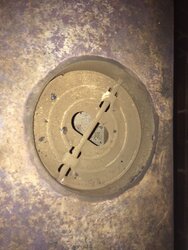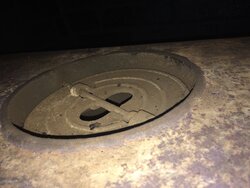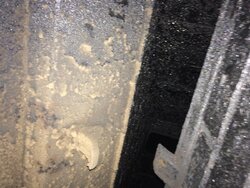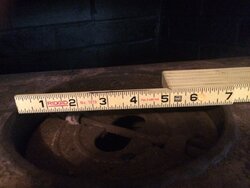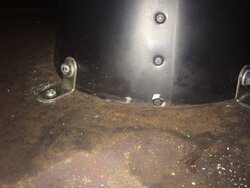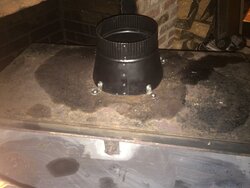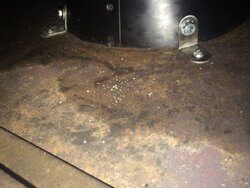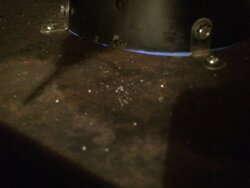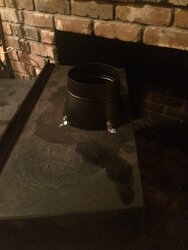clean everything really well and install a properly sized and insulated liner the stove will run like a dreamLooks like I do have a "slammer". Took off faceplate this morning and found this. What would be my next step to fix this problem?
Better N Bens
- Thread starter Firefigter148
- Start date
-
Active since 1995, Hearth.com is THE place on the internet for free information and advice about wood stoves, pellet stoves and other energy saving equipment.
We strive to provide opinions, articles, discussions and history related to Hearth Products and in a more general sense, energy issues.
We promote the EFFICIENT, RESPONSIBLE, CLEAN and SAFE use of all fuels, whether renewable or fossil.
You are using an out of date browser. It may not display this or other websites correctly.
You should upgrade or use an alternative browser.
You should upgrade or use an alternative browser.
- Status
- Not open for further replies.
jatoxico
Minister of Fire
Well you can see some of the problems with that kind of install right off. All the sweepings end up on top and behind the insert so it' should have been pulled to really clean it. The smoke has no clear path so it's drafting lousy when its cool, so at startup and as it burns down. That means there's an opportunity for CO to get back into the house. Also since you can't use the original damper you're likely to get cold drafts and creosote smell in the house.Looks like I do have a "slammer". Took off faceplate this morning and found this. What would be my next step to fix this problem?
Best fix is a full liner to the top and a block-off plate to isolate the warm house from the chimney. Many of those old units use an 8" liner and the newer ones use 6" so there's a decision to be made about how much money to spend on this getting this insert working safely.
Want size is the current clay liner? Need to know what size it can accept. Also is this an interior or exterior chimney? I'm thinking if the last sweep just brushed everything down and left all that creosote he's not the guy for you. That stuff could ignite sitting on the insert so maybe you want to have another certified guy out to evaluate you for safety/clearances and options.
Experts here can talk you through it as well if you are a DIYer.
Well you can see some of the problems with that kind of install right off. All the sweepings end up on top and behind the insert so it' should have been pulled to really clean it. The smoke has no clear path so it's drafting lousy when its cool, so at startup and as it burns down. That means there's an opportunity for CO to get back into the house. Also since you can't use the original damper you're likely to get cold drafts and creosote smell in the house.
Best fix is a full liner to the top and a block-off plate to isolate the warm house from the chimney. Many of those old units use an 8" liner and the newer ones use 6" so there's a decision to be made about how much money to spend on this getting this insert working safely.
Want size is the current clay liner? Need to know what size it can accept. Also is this an interior or exterior chimney? I'm thinking if the last sweep just brushed everything down and left all that creosote he's not the guy for you. That stuff could ignite sitting on the insert so maybe you want to have another certified guy out to evaluate you for safety/clearances and options.
Experts here can talk you through it as well if you are a DIYer.
jatoxico I just bought the house so I am still looking for a chimney guy. I measures the stove damper and its 7" ID. I was thinking a 6" liner and put an adapter on the instert. It is a interior chimney. I am more than comfortable doing stuff on my own. I just don't know how to adapt the stove damper to the liner. I am assuming it goes on the inside of the damper
jatoxico
Minister of Fire
I just don't know how to adapt the stove damper to the liner. I am assuming it goes on the inside of the damper
@bholler can probably point you to exactly what you need to adapt that unit to a liner. I'll just add there are some relatively inexpensive EPA insert options that are well thought of. Englander sold through HD comes to mind. They are good sturdy units with good customer service (have a rep here). Just saying you may want to consider that too.
Often times if a chimney goes unused for a long period of time the creosote will all fall to the bottom. Particularly if there is no cap. Before I used it I would pull those panels off and get a look in there.
I've seen many of these direct connect installs where the liner is smashed nearly flat to get it through the fireplace damper. That could be contributing to your draft issues.
*Edit. Now I see I missed the last page of the discussion. Lol
I've seen many of these direct connect installs where the liner is smashed nearly flat to get it through the fireplace damper. That could be contributing to your draft issues.
*Edit. Now I see I missed the last page of the discussion. Lol
Don't have a new stove in the budget at this time. I want to fix this to be safe, and then down the line get a new one.
Webby I just pulled them off and cleaned out everything. I'm not trying to figure out to put it back together.
Webby I just pulled them off and cleaned out everything. I'm not trying to figure out to put it back together.
If it is 7" then you should use a 7" liner. and an appliance adapter to match that linerjatoxico I just bought the house so I am still looking for a chimney guy. I measures the stove damper and its 7" ID. I was thinking a 6" liner and put an adapter on the instert. It is a interior chimney. I am more than comfortable doing stuff on my own. I just don't know how to adapt the stove damper to the liner. I am assuming it goes on the inside of the damper
jatoxico
Minister of Fire
Don't have a new stove in the budget at this time. I want to fix this to be safe, and then down the line get a new one.
I hear you, new house and plenty of places to spend money! Offhand you will need an adapter, liner and cap for the top. Measure your current flue to see what can fit. The old damper will more than likely need to be cut back or removed to allow the install of the liner. If the experts think a 6" liner will work that would be best so you're not buying a new one later down the line.
Pictures of what you have inside and out will help. Probably would be best to remove the insert and put it to the side. Not sure how you could deal with the old damper w/o doing that. In addition there's likely a whole lot of creosote above the old damper and in the smoke shelf that should be vacuumed out.
yeah you could sell it i am sure but it is not worth all that much $300 to $400 at the highestDo you think I would be able to sell this insert?
jatoxico
Minister of Fire
It would probably work ok depending on the height. I personally would not do it but it might work@bholler can that stove run w/ a 6" liner?
jatoxico
Minister of Fire
As an option run the 6" liner to use the stove for this season. My thinking is a new EPA certified stove will need dry wood which will be tough to come by right now whereas the older stove will tolerate semi-seasoned wood. Run it hot, keep it clean and swept and figure on replacing it before next year.It would probably work ok depending on the height. I personally would not do it but it might work
Buy in the off season and you might catch a good clearance sale. At the same time get your wood drying for the new one so it will be at least half decent. If you are buying cord wood and if you can swing it buy an extra cord. That would put you in pretty fair shape.
Finding a qualified sweep or a market for the stove could be a problem in Monroe, Louisiana. Except for maybe Boudreau & Thibodeau Chimney Sweeping, Crawfish Pots and Boilers LLC.
Looking at that damper I see a problem with installing the adapter and liner on that pup.
Looking at that damper I see a problem with installing the adapter and liner on that pup.
why i have done it many times on similar unitsLooking at that damper I see a problem with installing the adapter and liner on that pup.
why i have done it many times on similar units
Didn't say it couldn't be done. Just saying that as a rookie I see it as a problem.

Its not hard just notch for the adapter for the rod and then possibly grind down the damper a little so it clears the adapter. It is still the easiest and best way to install it.Didn't say it couldn't be done. Just saying that as a rookie I see it as a problem.
Ugh. Looks like all the chimney cleaning sote has landed on top of the insert. It should have a full stainless steel liner installed after the insert and chimney are thoroughly cleaned. This will need a flue collar attached to the insert.
Hi everyone so a little update. I cleaned the chimney and I modified a adapter to the top of the insert. I used angle brackets and tap threaded them in. My next question is how would I seal where the adapter meets the top of the stove?
The temps are to high post a picture of it they usually dont need sealed but the only thing that will hold up to the temps there is furnace cement.Was thinking hi temp rtv silicon or hi temp epoxy
- Status
- Not open for further replies.
Similar threads
- Replies
- 12
- Views
- 655
- Replies
- 2
- Views
- 763
- Replies
- 4
- Views
- 623
- Replies
- 6
- Views
- 1K


